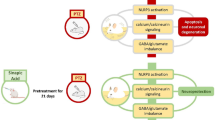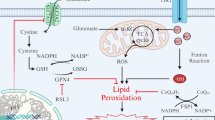Abstract
The biochemical and cellular changes that occur following the administration of 1-methyl-4-phenyl-1,2,3,6-tetrahydropyridine (MPTP) are remarkably similar to that seen in idiopathic Parkinson’s disease(PD). There is growing evidence indicating that reactive oxygen species (ROS), reactive nitrogen species (RNS) and inflammation are a major contributor to the pathogenesis and progression of PD. Hence, we investigated whether 7-nitroindazole [neuronal nitric oxide synthase (nNOS) inhibitor], edaravone (free radical scavenger), minocycline [inducible NOS (iNOS) inhibitor], fluvastatin [endothelial NOS (eNOS) activator], pitavastatin (eNOS activator), etodolac [cyclooxygenase-2 (COX-2) inhibitor] and indomethacin (COX inhibitor) can protect against MPTP neurotoxicity in mice under the same conditions. For the evaluation of each drug, the levels of dopamine, DOPAC and HVA were quantified using HPLC with an electrochemical detector. Four administrations of MPTP at 1-h intervals to mice produced marked depletion of dopamine, DOPAC (3,4-dihydroxyphenylacetic acid) and HVA (homovanilic acid) in the striatum after 5days. 7-Nitroindazole prevented dose-dependently a significant reduction in dopamine contents of the striatum 5days after MPTP treatment. In contrast, edaravone, minocycline, fluvastatin, pitavastatin, etodolac and indomethacin did not show the neuroprotective effect on MPTP-induced striatal dopamine, DOPAC and HVA depletions after 5days. The present study demonstrates that the overexpression of nNOS may play a major role in the neurotoxic processes of MPTP, as compared with the production of ROS, the overexpression of iNOS, the modulation of eNOS and the involvement of inflammatory response. Thus our pharmacological findings provide further information for progressive neurodegeneration of the nigrostriatal dopaminergic neuronal pathway.








Similar content being viewed by others
References
Agid Y (1991) Parkinson’s disease: pathophysiology. Lancet 337:1321–1324
Araki T, Tanji H, Fujihara K, Kato H, Itoyama Y (1999) Increases in [3H]FK-506 and [3H]L-NG-nitro-arginine binding in the rat brain after nigrostriatal dopaminergic denervation. Metab Brain Dis 14:21–31
Araki T, Mikami T, Tanji H, Matsubara M, Imai Y, Mizugaki M, Itoyama Y (2001) Biochemical and immunohistological changes in the brain of 1-methyl-4-phenyl-1,2,3,6-tetrahydropyridine (MPTP)-treated mouse. Eur J Pharm Sci 12:231–238
Bauer MK, Lieb K, Schulze-Osthoff K, Berger M, Gebicke-Haerter PJ, Bauer J, Fiebich BL (1997) Expression and regulation of cyclooxygenase-2 in rat microglia. Eur J Biochem 243:726–731
Beal MF (2003) Mitochondria, oxidative damage, and inflammation in Parkinson’s disease. Ann NY Acad Sci 991:120–131
Beckman JS, Beckman TW, Chen J (1990) Apparent hydroxyl radical production by peroxynitrite: implications for endothelial injury from nitric oxide and superoxide. Proc Natl Acad Sci U S A 87:1620–1624
Beckman JS, Ischiropoulos H, Zhu L (1992) Kinetics of superoxide dismutase- and iron-catalyzed nitration of phenolics by peroxynitrite. Arch Biochem Biophys 298:438–445
Bernheimer H, Birkmayer W, Hornykeiwicz O, Jellinger K, Seitelberger F (1973) Brain dopamine and the syndromes of Parkinson and Huntington. Clinical, morphological and neurochemical correlations. J Neurol Sci 20:415–455
Bredt DS, Snyder SH (1990) Isolation of nitric oxide synthase, a calmodulin-requiring enzyme. Proc Natl Acad Sci U S A 87:682–685
Bredt DS, Snyder SH (1994) Nitric oxide: a physiologic messenger molecule. Ann Rev Biochem 63:175–195
Breidert T, Callebert J, Heneka MT, Landreth G, Launay JM, Hirsch EC (2002) Protective action of the peroxisome proxisome proliferator-activated receptor-gamma agonist pioglitazone in a mouse model of Parkinson’s disease. J Neurochem 82:615–624
Dauer W, Przedborski S (2003) Parkinson’s disease: mechanisms and models. Neuron 39:889–909
Dawson TM, Snyder SH (1994) Gases as biological messengers: nitric oxide and carbon monoxide in the brain. J Neurosci 14:5147–5159
Dawson VL, Dawson TM, London ED, Bredit DS, Snyder SH (1991) Nitric oxide mediates glutamate neurotoxicity in primary cultures. Proc Natl Acad Sci U S A 88:6268–6371
Dehmer T, Lindenau J, Haid S, Dichgans J, Schultz JB (2000) Deficiency of inducible nitric oxide synthase protects against MPTP toxicity in vivo. J Neurochem 74:2213–2216
Di Monte DA, Royland JE, Anderson A, Castagnoli K, Castagoli Jr N , Langston JW (1997) Inhibition of monoamine oxidase contributes to the protective effect of 7-nitroindazole against MPTP neurotoxicity. J Neurochem 69:1771–1773
Endres M, Laufs U, Huang Z, Nakamura T, Huang P, Moskowitz MA, Liao JK (1998) Stroke protection by 3-hydroxy-3-methylglutaryl (HMG)-CoA reductase inhibitors mediated by endothelial nitric oxide synthase. Proc Natl Acad Sci U S A 95:8880–8885
Feng ZH, Wang TG, Li DD, Fung P, Wilson BC, Liu B, Ali SF, Langenbach R, Hong JS (2002) Cyclooxygenase-2-deficient mice are resistant to 1-methyl-4- phenyl-,2,3,6-tetrahydropyridine-induced damage of dopaminergic neurons in the substantia nigra. Neurosci Lett 329:354–358
Hantraye P, Brouillet E, Ferrante R, Pafi S, Dolan R, Matthews RT, Beal MF (1996) Inhibition of neuronal nitric oxide synthase prevents MPTP-induced Parkinsonism in baboons. Nat Med 2:1017–1021
Hasegawa E, Takeshige K, Oishi T, Murai Y, Minakami S (1990) 1-Methylphenylpyridinium (MPP+) induces NADH-dependent superoxideformation and enhances NADH-dependent lipid peroxidation in bovine heart submitochondrial particles. Biochem Biophys Res Commun 170:1049–1055
Hirsh E, Graybiel AM, Agid YA (1988) Melanized dopaminergic neurons are differentially susceptible to degeneration in Parkinson’s disease. Nature 334:345–348
Hirsch EC, Breidert T, Rousselet E, Hunot S, Hartmann A, Michel PP (2003) The role of glial reaction and inflammation in Parkinson’s disease. Ann NY Acad Sci 991:214–228
Hurley SD, O'Banion MK, Song DD, Arana FS, Olschowka JA, Haber SN (2003) Microglial response is poorly correlated with neurodegeneration following chronic, low-dose MPTP-administration in monkeys. Exp Neurol 184:659–668
Ignarro LJ (1990) Biosynthesis and metabolism of endothelium-derived nitric oxide. Ann Rev Pharmacol Toxicol 30:535–560
Ischiropoulos H, Zhu L, Chen J (1992) Peroxynitrite-mediated tyrosine nitration catalyzed by superoxide dismutase. Arch Biochem Biophys 298:431–437
Kurosaki R, Akasak M, Michimata M, Matsubara M, Ima Y, Araki T (2003) Effects of Ca2+ antagonists on motor activity and the dopaminergic system in aged mice. Neurobiol Aging 24:315–319
Liberatore GT, Jackson-Lewis V, Vukosavic S, Mandir AS, Vila M, McAuliffe WG, Dawson VL, Dawson TM, Przedborski S (1999) Inducible nitric oxide synthase stimulates dopaminergic neurodegeration in the MPTP model of Parkinson disease. Nat Med 5:1403–1409
Lonart G, Johanson KM (1992) Inhibitory effects of nitric oxide on the uptake of [3H]dopamine and [3H]glutamate by striatal synaptosomes. J Neurochem 63:2108–2117
Marletta MA (1994) Nitric oxide synthase: aspects concerning structure and catalysis. Cell 78:927–930
McGeer PL, Itagaki S, Boyes BE, McGeer EG (1988) Reactive microglia and positive for HLS-DR in the substantia nigra of Parkinson’s and Alzheimer’s disease brains. Neurology 38:1285–1291
Minghetti L, Walsh DT, Levi G, Perry VH (1999) In vivo expression of cyclooxygenase-2 in rat brain following intraparenchymal injection of bacterial endotoxin and inflammatory cytokines. J Neuropathol Exp Neurol 58:1184–1191
Moncada S, Palmer RM, Higgs EA (1991) Nitric oxide: physiology, pathophysiology and pharmacology. Pharmacol Rev 43:109–142
Muramatsu Y, Kurosaki R, Watanabe H, Michimata M, Matsubara M, Imai Y, Araki T (2003) Cerebral alterations in a MPTP-mouse model of Parkinson’s disease-an immunocytochemical study. J Neural Transm 110:1129–1144
Murphy S, Simmons ML, Agullo L, Garcia A, Feinstein DL, Galea E, Reis DJ, Minc-Colomb D, Schwartz JP (1993) Synthesis of nitric oxide in CNS glial cells. Trends Neurosci 16:323–328
Nathan C, Xie QW (1994) Nitric oxide synthases: roles, tolls, and controls. Cell 78:915–918
O’Banion MK (1999) COX-2 and Alzheimer’s disease: potential roles in inflammation and neurodegeneration. Expert Opin Invest Drugs 8:1521–1536
Pasinetti GM (1998) Cyclooxygenase and inflammation in Alzheimer’s disease: experimental approaches and clinical interventions. J Neurosci Res 54:1–6
Ravina BM, Fagan SC, Hart RG, Hovinga CA, Murphy DD, Dawson TM, Marler JR (2003) Neuroprotective agents for clinical trials in Parkinson’s disease: a systematic assessment. Neurology 60:1234–1240
Rice-Evans CA (1994) Formation of free radicals and mechanisms of action in normal biochemical processes and pathological states. In: Rice-Evans CA, Burdon RH (eds) Free radical damage and its control. Elsevier, Amsterdam, pp 131–153
Samuelsson B (1991) Arachidonic acid metabolism: role in inflammation. Z Rheumatol Suppl 50:3–6
Schulz JB, Matthews RT, Muqit MMK (1995) Inhibition of neuronal nitric oxide synthase by 7-nitroindazole protects against MPTP-induced neurotoxicity in mice. J Neurochem 64:936–939
Selley ML (2005) Simvastatin prevents 1-methyl-4-phenyl-1,2,3,6-tetrahydropyridine-induced striatal dopamine depletion and protein tyrosine nitration in mice. Brain Res 1037:1–6
Smith WL, DeWitt DL, Garavitro RM (2000) Cyclooxygenases: structural, cellular, and molecular biology. Annu Rev Biochem 69:145–182
Sriram K, Pai KS, Boyd MR, Ravindranath V (1997) Evidence for generation of oxidative stress in brain by MPTP: in vitro and in vivo studies in mice. Brain Res 749:44–52
Teismann P, Tieu K, Choi DK, Wu DC, Naini A, Hunot S, Vila M, Jackson-Lewis V, Przedborski S (2003) Cyclooxygenase-2 is instrumental in Parkinson’s disease. Proc Natl Acad Sci U S A 100:5473–5478
Tipton KF, Singer TP (1993) Advances in our understanding of the mechanisms of the neurotoxicity of MPTP and related compounds. J Neurochem 61:1191–1206
Watanabe Y, Kato H, Araki T (2008) Protective action of neuronal nitric oxide synthase inhibitor in the MPTP mouse model of Parkinson’s disease. Metab Brain Dis 23:51–69
Wenzel SE (1997) Arachidonic acid metabolites: mediators of inflammation in asthma. Pharmacotherapy 17:3S–12S
Wu DC, Jakson-Lewis M, Vila M, Tieu K, Teismann C, Vadseth C, Choi DK, Ischiropoulos H, Przedborski S (2002) Blockade of microglial activation is neuroprotective in the 1-methyl-4-phenyl-1,2,3,6-tetrahydropyridine mouse model of Parkinson disease. J Neurosci 22:1763–1771
Author information
Authors and Affiliations
Corresponding author
Rights and permissions
About this article
Cite this article
Yokoyama, H., Yano, R., Aoki, E. et al. Comparative pharmacological study of free radical scavenger, nitric oxide synthase inhibitor, nitric oxide synthase activator and cyclooxygenase inhibitor against MPTP neurotoxicity in mice. Metab Brain Dis 23, 335–349 (2008). https://doi.org/10.1007/s11011-008-9096-3
Received:
Accepted:
Published:
Issue Date:
DOI: https://doi.org/10.1007/s11011-008-9096-3




